My View on Zazou
By Erna Adelson
Most of you already know Zazou Hoffman as the young rider who competes bi-coastally, both near her hometown in Santa Monica, CA and on the east coast circuit with Missy Clark. Her bio also reveals that among other notable accomplishments, Hoffman was one of seven elite riders chosen to work with Olympic Chef d’Equipe George Morris in Wellington, FL and has competed in the Medal Finals for the past three years. Additionally, she took first at Maclay Regional, 5th in “the Medal” at Harrisburg, 5th in the USET Talent Search East at Gladstone, 3rd in the WCE, and recently 3rd in the Maclay Finals.
Throughout her eventful career, Hoffman has also managed to find a way to make the sport accessible to all enthusiasts by regularly writing about her experiences. Her columns, found in CA Riding Magazine and in this newsletter, offer counsel and insight that resonates with all riders and provides a window to the inside of the most coveted places in the industry. As a writer, a rider, and a bi-coastal traveler myself, I was thrilled at the opportunity to interview Zazou Hoffman. Since our schedules and locations would never allow us to do this in person, of course, I did the next best thing to meeting her: I “friended” her on Facebook. This way, I gained insight into Zazou not just as a rider but as one of the most driven and busiest teenagers that I have ever (almost) met. Read on for Zazou’s revelations about keeping up with schoolwork, her remote social life, and even Tyra Banks.
ERNA: When did you know that much of your future budget and time would be dedicated mostly to competitive horseback riding? Did you ever question whether or not it was worth such an investment?
ZAZOU: Riding has been a part of my life since I was really little. I mean, I have pictures of me when I was three years old next to my mom’s horses and there has never been a doubt in my mind that horses would be a part of my life. Of course, when I was little, I had NO idea how much time and money had to be invested in the sport to get to the top. I can honestly say that I have never doubted that I wanted to put in all the time I possibly could to work at getting better, but money is something that is not really in my control. My family has been wonderful at helping me get to where I am, but there are times when it is very upsetting to see both my parents, and my brother making sacrifices that wouldn’t need to be made if I didn’t ride. We have all decided though that I am lucky enough to have found what I am passionate about at a young age, and we will all work hard to make it happen.
ERNA: Besides the time change, how did you have to adjust to riding and training primarily on the east coast? Are there any major differences between east and west coast venues?
ZAZOU: Well, the time change can actually be a pretty big part of it! But, in terms of the actual horseback riding, it’s about getting in the ring and getting the job done no matter where you are. I have had the incredible opportunity to be working with Missy Clark and John Brennan back east, and I learn something new every single day, but a lot of what I am learning is simply an extension of what I have learned from Meredith Bullock, who trains me in California. Some of the horses I am riding on the east coast are definitely nicer than some of the ones I have ridden at home, but nothing is “push-button” and it’s all just about riding. In terms of the venues, I have found that everything back east is just bigger; there are more horses, more people, and more horse shows.
ERNA: Could you elaborate on how you ended up riding with Missy Clark?
ZAZOU: I received the Ronnie Mutch Working Student Scholarship in 2005, which allowed me to travel to WEF to ride with Missy Clark for two weeks. Missy and I developed a great relationship and she invited me to continue riding with her as a working student. It all kind of took off from there!
ERNA: Could you also tell us a bit about your decision to continue riding with Missy as far away as Vermont rather than a similar caliber west coast trainer?
ZAZOU: There were a lot of things that factored into this decision. Basically though, Missy’s barn is fabulous. Missy and John and I immediately got along, the staff there works harder than any I’ve seen, the horses are amazing, and I simply saw an opportunity that I didn’t think I could turn down. I was really just coming off the ponies, and the offer of a working student position at North Run seemed irresistible. I had had lots of riding opportunities in California, but nothing that could compare to this. I think that if you want to be really competitive you need nation-wide exposure and you need to be learning from the best people you can put yourself in contact with. Learning from as many of the good people as possible helps a rider to understand what works for them and what doesn’t, as well as what they would like to take with them into their professional career.
ERNA: Do you now consider yourself an east coast rider or representing both the west and the east coasts?
ZAZOU: I consider myself as a rider that represents both coasts. I still have a fantastic trainer in California (Meredith Bullock), and while I may not go to as many horse shows with her, this is only because I do not regularly show a horse that I own. And then I have great trainers on the east coast with North Run. I consider my self bicoastal because I try to compete and continue learning in any state and at any horse show where I find myself.
ERNA: Besides riding, you also write a couple of regular columns. How did that part of your career materialize? Since writing seems to be another passion of yours, do you have any aspirations as a writer?
ZAZOU: My writing kind of evolved on its own. I really just started by doing a couple of small things for California Riding and branched off from there. This sport has given me a lot in my life and I figure all I can do is keep trying to give back in some ways. I think interviewing the great people in the sport is educational for me, and having it published gets it out there so others can learn as well. I have also gotten to the point in my riding where I have had the opportunity to experience a lot of new and different things that I think are important to share with others. I haven’t really thought much about my future in writing, but like I said I would really like to continue giving back to this sport in as many ways as I can.
ERNA: The question everyone probably asks you right now: Have you thought at all about which college/university you might attend? Besides a stellar riding program and possible scholarship money, what other factors are going into such a pivotal decision?
ZAZOU: Luckily, I am only a junior in high school, so I haven’t had to do my college apps yet, but I’m dreading the day. I’ve thought about college a little though, and my main priority is getting the best education I can. I would like to keep riding in college, but I’m not set on riding for a college team unless I think it’s going to help me get into a school I want to go to. From the little bit of research I’ve done, the school I would love to go to (but I think is a long shot to get into) would be Brown. Both my parents went to Berkeley, so that is also a school I have thought about. The whole admission process seems to be so complicated and so random that I think it is important to keep an open mind about what school I want to go to.
ERNA: High School is a notoriously tough time for teenagers. How do you deal with the frustrations of highly competitive riding–less than perfect outings, travel, and the added workload in addition to the pressures of teenagerhood (if there are any)?
ZAZOU: Oh boy, it can all get really stressful. I actually just started taking all of my classes online this year, and that has really helped. I am taking four Advanced Placement classes and one honors class through four different online programs. My parents and I agreed that the only way I would do online classes is if we felt that my education would in no way be compromised, so after a lot of research I found that UC Davis, UC Irvine, Stanford, and APEX had programs that I could rely on. Having the opportunity to take my classes online has been extremely helpful in making things less stressful. This has allowed me to stay back east all fall, which removed the added stress of traveling back and forth from CA to the east coast for each horse show. My friends at home are great though, and they are always there to be supportive. There is a great dynamic among the kids at North Run (Missy Clark’s barn) and, of course, my friends in California are always happy to see me when I am home. It is very comforting to have people around you who can help if you need anything.
ERNA: What is currently on your iTunes Playlist?
ZAZOU: I listen to anything and everything! I actually like just about every type of music so my iTunes playlist is all over the place. I always have it on shuffle to keep things interesting. That way I can get my fix of rock, hip hop, country, rap, and a little bit of everything else there is. I’ve got some of the Beatles, some Red Hot Chili Peppers, a little JT, some Taylor Swift…. the list goes on. I actually just saw the movie Slumdog Millionaire (which was fantastic and I recommend it to everybody) so I am currently a bit obsessed with the soundtrack, which was also amazing.
ERNA: I have gotten to know you a little better through some thorough facebook stalking. (Forgive me) It seems that you have somehow managed to balance your career and maintain a social life. Is there anything you ever feel like you are missing out on due to the demands of your competition and training schedule? (Prom, travel, etc)
ZAZOU: There are always social sacrifices that I have to make for my riding, and while I may have been a little bummed at the time, I have never felt that I have regretted any of them. Facebook has actually been a great way to stay in touch with my west coast friends when I’m back east and my east coast friends when I am home. It has definitely helped me keep a healthy social life, and like I said before I have a group of good friends who are really fun to hang out with. In terms of missing out on things, I’m hoping I will be home for Prom (at least my senior year). I have to say, some of my friends are going to Vienna, Budapest, and Munich for a choir trip, and I’d being lying if I said I wasn’t a little bit jealous, but then again, I probably get to travel more than any of them.
ERNA: I did also see that you listed America’s Next Top Model (ANTM) as one of your favorite shows. Hate to admit it, but I’m also sort of addicted…OK. Tyra Banks: Insane or a genius?
ZAZOU: Oh, ANTM has definitely consumed a large amount of my life for the past couple years! In my opinion, Tyra Banks is completely out of her mind, but the catch is, that her craziness is what makes her such a genius! It’s a great show–very addictive.
Thank you so much for doing this interview with me, Erna. Your questions were great, and I had a lot of fun answering them. I’m sure we will keep in touch through Facebook!
ERNA: Undoubtedly when I hear about Zazou Hoffman’s next triumph in the show ring, I won’t be the only person to offer my congratulations in the form of a facebook memo. But if I’m not mistaken, Zazou is a girl that collects wall posts like ribbons and cherishes them just as much.
About Erna L. Adelson
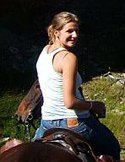 A bi-coastal writer and rider, Erna’s exposure to horses started at age 7, spending her summers at Road’s End Farm in Chesterfield, New Hampshire. In her junior year in high school, Erna achieved her first byline in the Montclair Times, the large local weekly paper of Montclair, NJ, and worked as a staff writer throughout her senior year in high school. Erna studied writing and sociology at UCSB and continued to ride as a working student With Rebecca Atwater at Santa Barbara Stables and at Creek Hollow Ranch in San Diego. She joined the staff at SB Fitness Magazine and also became a regular contributor to California Riding Magazine.
A bi-coastal writer and rider, Erna’s exposure to horses started at age 7, spending her summers at Road’s End Farm in Chesterfield, New Hampshire. In her junior year in high school, Erna achieved her first byline in the Montclair Times, the large local weekly paper of Montclair, NJ, and worked as a staff writer throughout her senior year in high school. Erna studied writing and sociology at UCSB and continued to ride as a working student With Rebecca Atwater at Santa Barbara Stables and at Creek Hollow Ranch in San Diego. She joined the staff at SB Fitness Magazine and also became a regular contributor to California Riding Magazine.
Erna’s work at Equestrisol has allowed her to combine her passions of writing, public relations, and horses and to retain her ties to the west coast. She now resides in New York City in a marketing position at Manhattan Saddlery, the successor to Miller’s Harness Company, and the sole destination for the equestrian community of the Big Apple.
 EqSol: Where are you from in Canada?
EqSol: Where are you from in Canada?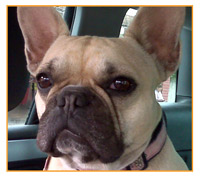 We do plan to have our first Blue Valley Farms horse show next summer at the end of July. We’re going to only have 150 horses, offer special incentives to California riders and more – I’ll give you the details when I have them.
We do plan to have our first Blue Valley Farms horse show next summer at the end of July. We’re going to only have 150 horses, offer special incentives to California riders and more – I’ll give you the details when I have them. EqSol: How did you become a course designer? What is your horse history?
EqSol: How did you become a course designer? What is your horse history?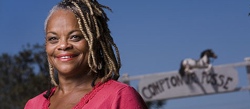 Horses have long served as a magical medium for the rehabilitation and uplifting of spirits and minds; equine therapy is frequently implemented as a social and vocational tool for the physically and mentally handicapped, former veterans, and inmates. In the 1992 film Into the West, a mysterious horse rescues two children from the poverty, hostility and discrimination of the projects of Ireland. Mayisha Akbar and riders from the Compton Junior Posse—a steadily growing group of kids from a Los Angeles suburb better known for gang violence than blue ribbons—are finding that their equine companions have an innate power to inspire them to dream of lives beyond gang involvement, just like the supernatural horse of the film. Changing the greater perceptions of the equestrian community, these new additions to the Southern California hunter and dressage arenas are really turning heads.
Horses have long served as a magical medium for the rehabilitation and uplifting of spirits and minds; equine therapy is frequently implemented as a social and vocational tool for the physically and mentally handicapped, former veterans, and inmates. In the 1992 film Into the West, a mysterious horse rescues two children from the poverty, hostility and discrimination of the projects of Ireland. Mayisha Akbar and riders from the Compton Junior Posse—a steadily growing group of kids from a Los Angeles suburb better known for gang violence than blue ribbons—are finding that their equine companions have an innate power to inspire them to dream of lives beyond gang involvement, just like the supernatural horse of the film. Changing the greater perceptions of the equestrian community, these new additions to the Southern California hunter and dressage arenas are really turning heads. The Compton Junior Posse is a 501.3.c. non-profit dedicated to encouraging inner city and underprivileged youth to become productive members of society. Using horses and horseback riding to teach responsibility, discipline, and self-esteem, founder Mayisha Akbar has managed to change the lives of hundreds of inner-city kids. This equine medium teaches them valuable social and interactive skills, motivates them to set both academic and career goals, as well as simply providing a place where they can seek refuge from the often violent environments in their neighborhoods. Out of her small, backyard stable, Akbar has seen two decades of kids grow into leaders and outstanding contributors to their local communities. “We have found that investing in these children through our equestrian program motivates our kids to achieve their goals,” she says. Akbar has also rescued over 100 horses through her ranch.
The Compton Junior Posse is a 501.3.c. non-profit dedicated to encouraging inner city and underprivileged youth to become productive members of society. Using horses and horseback riding to teach responsibility, discipline, and self-esteem, founder Mayisha Akbar has managed to change the lives of hundreds of inner-city kids. This equine medium teaches them valuable social and interactive skills, motivates them to set both academic and career goals, as well as simply providing a place where they can seek refuge from the often violent environments in their neighborhoods. Out of her small, backyard stable, Akbar has seen two decades of kids grow into leaders and outstanding contributors to their local communities. “We have found that investing in these children through our equestrian program motivates our kids to achieve their goals,” she says. Akbar has also rescued over 100 horses through her ranch. Early in the riding program, the Compton Junior Posse went mostly to rodeos. Akbar started to integrate English-style riding about three years ago after watching a flat class at a local horse show. “It was clearly so good for the horses to learn and progress the same way, and be judged the same way. Everyone walked, trotted, and cantered at the same time!” she noted, a big difference from rodeo chaos. Now, the Compton Junior Posse is primarily an English operation, and all of the rescue horses are trained under English saddle. Akbar says that since making the switch to English riding, she has seen Junior Posse riders benefit from more structure and discipline. “I was worried about not being accepted at hunter and dressage shows,” says Akbar, “but the English world has been so welcoming, so giving, and so warm! Everywhere we go we break norms. Everyone is so impressed with the athleticism and politeness of the Junior Posse riders—we are completely breaking equestrian stereotypes.”
Early in the riding program, the Compton Junior Posse went mostly to rodeos. Akbar started to integrate English-style riding about three years ago after watching a flat class at a local horse show. “It was clearly so good for the horses to learn and progress the same way, and be judged the same way. Everyone walked, trotted, and cantered at the same time!” she noted, a big difference from rodeo chaos. Now, the Compton Junior Posse is primarily an English operation, and all of the rescue horses are trained under English saddle. Akbar says that since making the switch to English riding, she has seen Junior Posse riders benefit from more structure and discipline. “I was worried about not being accepted at hunter and dressage shows,” says Akbar, “but the English world has been so welcoming, so giving, and so warm! Everywhere we go we break norms. Everyone is so impressed with the athleticism and politeness of the Junior Posse riders—we are completely breaking equestrian stereotypes.”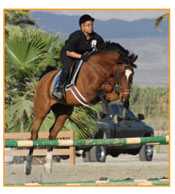 With the support of private donations, the Compton Junior Posse has grown from a refuge of necessity to a flourishing equestrian, husbandry, and educational program. Once on the verge of retiring due to the emotional toll of her work (Akbar estimates she’s lost 40 children over 20 years to gang violence), she has rallied in a most interesting way—by having introduced English style riding and equitation to the Junior Posse and finding support in some of the West Coast’s most prominent riders, trainers and veterinarians. She has forged ahead with a development plan for fundraising, support and maintenance of the program and now has some substantial goals, such as being the first inner city charter school and Interscholastic Equestrian League (IEL) team so students will be able to ride and receive PE credit from Junior Posse participation while they get core credits from regular schools. Additionally, as IEL participants, the members of the Compton Junior Posse would earn points toward collegiate equestrian scholarships when competing at IEL shows.
With the support of private donations, the Compton Junior Posse has grown from a refuge of necessity to a flourishing equestrian, husbandry, and educational program. Once on the verge of retiring due to the emotional toll of her work (Akbar estimates she’s lost 40 children over 20 years to gang violence), she has rallied in a most interesting way—by having introduced English style riding and equitation to the Junior Posse and finding support in some of the West Coast’s most prominent riders, trainers and veterinarians. She has forged ahead with a development plan for fundraising, support and maintenance of the program and now has some substantial goals, such as being the first inner city charter school and Interscholastic Equestrian League (IEL) team so students will be able to ride and receive PE credit from Junior Posse participation while they get core credits from regular schools. Additionally, as IEL participants, the members of the Compton Junior Posse would earn points toward collegiate equestrian scholarships when competing at IEL shows.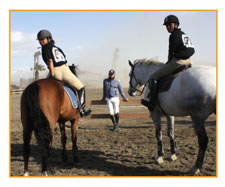 In the next year, Akbar’s goal is to raise 1 million dollars in gap funding while she awaits approval for federal and state grant money—primarily to hire a staff to support her efforts as the program grows. “I’m going to need a director of education, a director for the riding program, ranch management, an administrative coordinator, and capital for equipment, a hay barn, tractor, and classroom,” she says. She has also arranged for a long-term lease for her property so that the program can stay in its original location, which makes it convenient for the participants and their families. This evolving program that aspires to give more opportunities to inner city kids offers a new lease on life through horses and English riding. An unlikely bond that we hope can be everlasting.
In the next year, Akbar’s goal is to raise 1 million dollars in gap funding while she awaits approval for federal and state grant money—primarily to hire a staff to support her efforts as the program grows. “I’m going to need a director of education, a director for the riding program, ranch management, an administrative coordinator, and capital for equipment, a hay barn, tractor, and classroom,” she says. She has also arranged for a long-term lease for her property so that the program can stay in its original location, which makes it convenient for the participants and their families. This evolving program that aspires to give more opportunities to inner city kids offers a new lease on life through horses and English riding. An unlikely bond that we hope can be everlasting.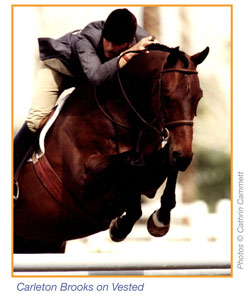 Carleton considers himself a producer, not a rider. He doesn’t just train; he channels the horse’s focus, bringing out the best in a horse by allowing them to do what they do best. His methods are inventive, inspired by the horses themselves, and by legendary horsemen from a variety of disciplines. “One of my favorite ways to allow a horse’s hind end to come up underneath him I learned from cutting horse trainers.” He wants the horse to guide him as to what works in their program.
Carleton considers himself a producer, not a rider. He doesn’t just train; he channels the horse’s focus, bringing out the best in a horse by allowing them to do what they do best. His methods are inventive, inspired by the horses themselves, and by legendary horsemen from a variety of disciplines. “One of my favorite ways to allow a horse’s hind end to come up underneath him I learned from cutting horse trainers.” He wants the horse to guide him as to what works in their program.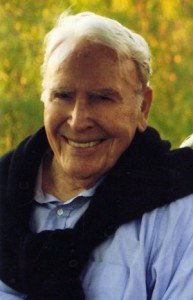 I’ve known John and Tish Quirk since my college years (let’s say for a couple of decades), where I took several semesters off to fuel my passion for horses and competing. One of my adventures away from campus was a brief trip to catch the glorious crown jewel of the indoor circuit, The National Horse Show, at the time still alive and well in NYC. I was supposed to compete but had sold my qualified hunter weeks before. Yet I still wanted to go. Somehow I ended up gallivanting around with the Quirks, publishers of HORSES Magazine, and had a grand time. A fond memory of my youth.
I’ve known John and Tish Quirk since my college years (let’s say for a couple of decades), where I took several semesters off to fuel my passion for horses and competing. One of my adventures away from campus was a brief trip to catch the glorious crown jewel of the indoor circuit, The National Horse Show, at the time still alive and well in NYC. I was supposed to compete but had sold my qualified hunter weeks before. Yet I still wanted to go. Somehow I ended up gallivanting around with the Quirks, publishers of HORSES Magazine, and had a grand time. A fond memory of my youth. A bi-coastal writer and rider, Erna’s exposure to horses started at age 7, spending her summers at Road’s End Farm in Chesterfield, New Hampshire. In her junior year in high school, Erna achieved her first byline in the Montclair Times, the large local weekly paper of Montclair, NJ, and worked as a staff writer throughout her senior year in high school. Erna studied writing and sociology at UCSB and continued to ride as a working student With Rebecca Atwater at Santa Barbara Stables and at Creek Hollow Ranch in San Diego. She joined the staff at SB Fitness Magazine and also became a regular contributor to California Riding Magazine.
A bi-coastal writer and rider, Erna’s exposure to horses started at age 7, spending her summers at Road’s End Farm in Chesterfield, New Hampshire. In her junior year in high school, Erna achieved her first byline in the Montclair Times, the large local weekly paper of Montclair, NJ, and worked as a staff writer throughout her senior year in high school. Erna studied writing and sociology at UCSB and continued to ride as a working student With Rebecca Atwater at Santa Barbara Stables and at Creek Hollow Ranch in San Diego. She joined the staff at SB Fitness Magazine and also became a regular contributor to California Riding Magazine.  JustWorld International is a recognized International 501(c)(3) charitable organization in the United States and in France. Currently, this non-profit raises funds through its 160 professional, junior and amateur ambassadors representing over 20 different countries. JWI also partners in fundraising with more than 50 International Show Jumping competitions around the globe. The proceeds help to develop long term, sustainable education projects, targeting communities where local organizations have evolved to help children who often fall beyond the reach of government and large-scale humanitarian programs. Besides addressing immediate needs such as food and clean water for these children, JustWorld and its partners provide educational programs that will begin to equip the children for future lives of self-sufficiency.
JustWorld International is a recognized International 501(c)(3) charitable organization in the United States and in France. Currently, this non-profit raises funds through its 160 professional, junior and amateur ambassadors representing over 20 different countries. JWI also partners in fundraising with more than 50 International Show Jumping competitions around the globe. The proceeds help to develop long term, sustainable education projects, targeting communities where local organizations have evolved to help children who often fall beyond the reach of government and large-scale humanitarian programs. Besides addressing immediate needs such as food and clean water for these children, JustWorld and its partners provide educational programs that will begin to equip the children for future lives of self-sufficiency.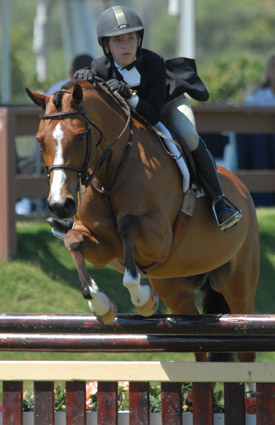 Always a fun class to watch – those pony kids are so adorable and such amazing little riders – the Zone 10 Pony Finals is open to all pony/rider combinations, and has three phases: model, under saddle and over fences. Ribbons are awarded to twelfth place for each phase, along with a champion and reserve champion for each height section, and an overall champion and overall reserve champion.
Always a fun class to watch – those pony kids are so adorable and such amazing little riders – the Zone 10 Pony Finals is open to all pony/rider combinations, and has three phases: model, under saddle and over fences. Ribbons are awarded to twelfth place for each phase, along with a champion and reserve champion for each height section, and an overall champion and overall reserve champion.